Flechtner F.M., Gruber Th., G?ntner A., Mandea M., Rothacher M., Sch?ne T., Wickert J. (Eds.) System Earth via Geodetic-Geophysical Space Techniques
Подождите немного. Документ загружается.

344 H. Reinhardt et al.
information from neighbouring gauge stations into data gaps. Our method of pref-
erence is based on Multi-Channel-Singular-Signal-Analysis (MSSA) as explained
in detail in Kondrashov and Ghil (2006). Here the inserted information in the data
gaps comes from the spatio-temporal covariance structure of the other gauges in the
same region.
The procedure begins with inserting zeros instead of the data gaps (though one
gets the same results when inserting random numbers or linear trends). We use a
two-fold iteration. The inner iteration uses the following steps:
1. Calculate the leading RC of the new time-series (with inserted zeros) using
MSSA.
2. At the position of the data gap insert the values of the RC.
3. Recalculate the leading RC again and insert these (new) values at the data-gaps.
4. Carry out these operations until convergence of the new (inserted) values is
reached.
5. Perform the same with the next RC by starting with the resulting reconstructed
time-series of the previous RC.
When a sufficient number of RCs is calculated, we get a first gap-filled signal.
This result is then again inserted in step 1. We perform this outer iteration until
convergence is reached. This is done for each region of gauges separately.
Best Parameters: The dominant oscillation of the plain time series is the annual
cycle. In our study we only are interested in multi-annual oscillations and the lin-
ear trend. Therefore the annual cycle is removed by subtracting the mean of all
Januarys from each January and accordingly with the other months. In order to have
a common frame of variance, all variances where normalized to var = 1.
As shown in Kondrashov and Ghil (2006) the ideal window length M depends on
the type of signal to be reconstructed. Since we are interested in multi-year oscilla-
tions and trends, we choose multiples of 1 year i.e. M = 12; 24; 36; 48 months. A
larger M would reduce the ratio of filter epoch versus total time and consequently
the degrees of freedom.
We want to reconstruct only the dominant behaviour of the signal in the data gaps.
It turns out that only the first two RCs need to be considered. In Fig. 2 an example is
shown as a test case. Into the measurements at tide gauge Fort Myers/Florida shown
in grey (right panel) a large artificial gap from 1967 to 1975 is introduced. The left
panel shows time s eries of the RC’s for this gap where our method of reconstructing
sea level from surrounding station data is tested. The measurements at the artificial
gap were withheld from the analysis and filled with our method depicted as black
curve in Fig. 1 (left). Comparison with the original data shows good agreement.
The correlation between both, original and filled gap, is 0.97. Thus the gap filling
method appears to be reasonable and successful.
Signal filtering: MSSA can also be used to split the signal in trend, oscillations
and high-frequent noise. In the gauge data (without annual cycle) the dominant sig-
nal is the trend. Time series analysis of the 1st RC shows that low f requencies (i.e.
a linear trend) dominate the signal. In higher RCs the major frequencies are in the
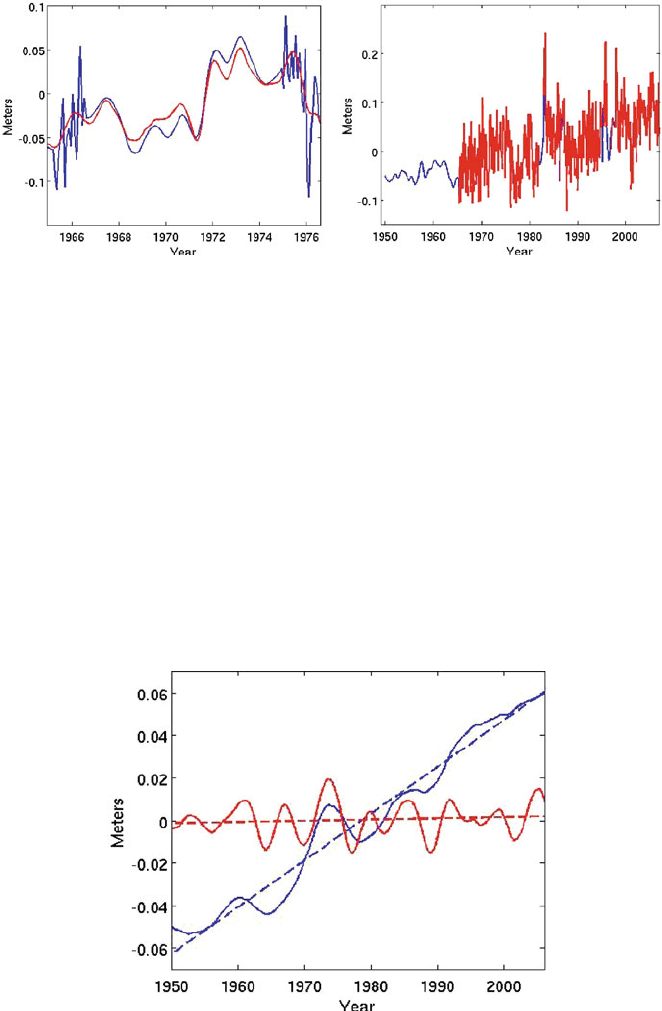
Sea Level Rise in North Atlantic Derived from Gap Filled Tide Gauge Stations 345
Fig. 2 The left panel shows in grey the sum of RCs 1 and 2 of the original time series of gauge Fort
Myers/Florida (M = 12). An artificial gap for the years 1967 to 1975 was filled with our method
(black). The correlation between both for the years 1967–1975 is 0.97. The right panel shows the
full measured time (grey) and the how the original data gaps were filled (black)
annual to sub-annual scale. This is depicted in Fig. 3 the 1st RC (black) and 2nd
RC (grey) are displayed together with their respective trends. The window length is
M = 60.
In the following section we calibrate the sea surface height of IFEOM model with
the time series of the reconstructed tide gauges. The IFEOM fields are provided as
pentads (5 year means) from 1950 to 1994 which result from an analysis of historic
fields of temperature and salinity (Lozier et al., 1995). Accordingly, gap-filled tide
gauge time series are smoothed with MSSA using a window length M = 60 for
the gap-filled time span of 1950–2006. We used the resulting smoothed time-series
from 1950–1994 to calibrate IFEOM. In Fig. 3 the trend of the gap filled time series
Fig. 3 The gap filled time series at gauge Fort Myers/Florida, the 1. RC (black) and 2. RC (grey)
and their respective trends. The window length is M = 60. The trend is confined to 1. RC
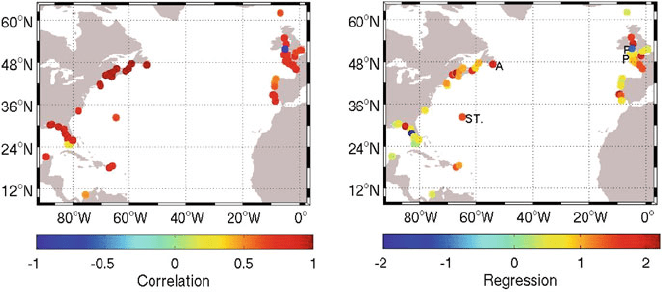
346 H. Reinhardt et al.
is confined completely to 1st RC. Including only the 1st RC for calibration of 5-year
mean values seems to be reasonable.
4 Reduced Number of Gauges and Calibration of IFEOM
Next we consider a series of results from the Inverse Finite Element Ocean Model
(IFEOM) which was applied to hydrographic data to obtain a sequence of dynamic
topography (Sidorenko et al., 2008). The series consists of nine realisations which
are available as means for the periods from 1950–1954 to 1990–1994. The model
circulation is in equilibrium with spatial gradients of dynamic topography. A bias or
shift in the surface reference has no dynamic consequence and cannot be determined
by the inverse model. The bias was therefore arbitrarily set to zero mean for each of
the pentads. Thus an undetermined shift exists from one realisation to another. The
tide gauge data were now used to determine the interpentadal shifts.
For calibration of IFEOM we want to rely on stable tide gauges only. We per-
formed reconstructions of data gaps using different window lengths M = 12; 24;
36; 48 months. All gauges with correlation below 0.8 (20 gauges) and difference
in regression greater 0.5 (22 gauges) for different window lengths where omitted.
Six gauges of the region Texas where discarded because they possess strong posi-
tive trends, different from all other gauges. This could be explained by local land
subduction due to oil exploitation, which cannot be corrected by the PGR model
of Peltier. Every station containing less than 25% of data between 1950 and 1994
was omitted (26 gauges). Two remaining African stations (Santa Cruz de Tenerife
and Takoradi) were excluded from calibration due to significant variance in the tide
gauges resulting from unaccounted land-movements. This and the large ratio (see
Fig. 1) are the reasons for gap-filling to fail here. All together 53 gauges remain for
calibration from the 129 gauges originally used for gap filling (see Fig. 4).
Fig. 4 Correlation and regression between 53 consistent tide gauges and calibrated IFEOM model.
Good agreement is seen on the American coast, where the model input data resolution is also
the best
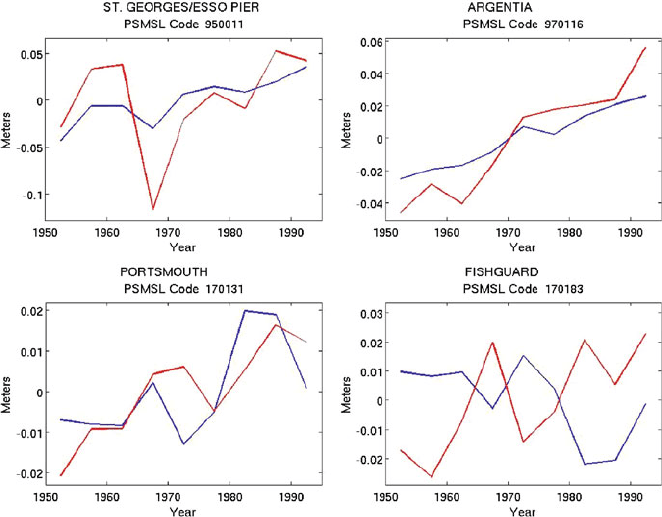
Sea Level Rise in North Atlantic Derived from Gap Filled Tide Gauge Stations 347
The calibration was carried out by fitting pentadal differences of IFEOM at gauge
locations to the tide gauges series in the least squares sense. The area mean recon-
structions show the trend in dynamic topography of 1.18; 1.18; 1.19; 1.19 mm/year
for the window lengths M = 12; 24; 36; 48 months, respectively.
Figure 4 shows the correlation and regression between the consistent tide gauges
and the calibrated IFEOM model. Good agreement is seen along the American coast
where hydrographic data used by IFEOM are dense. The gauges on the Canary
Islands and the African coast differ largely, possibly as a consequence of poor data
coverage in temperature and salinity fields.
A few time series of the gauges and the calibrated IFEOM Model (for the exact
locations see right side of Fig. 4) are shown in Fig. 5. The signal variance is gener-
ally greater in the Western Atlantic (St. Georges and Argentia). Gauge Portsmouth
is also well represented by IFEOM, whereas gauge Fishguard is anticorrelated to
IFEOM. This is perhaps due to the limited capabilities of IFEOM in the Irish Sea or
to undiscovered movement of the tide gauge.
The regional distribution of sea level rise calculated from calibrated IFEOM is
shown in Fig. 6 (left). The resulting mean is 1.18 mm/year sea level rise (SLR) for
the period of 1950–1994.
Fig. 5 Time series of tide gauges (black) and calibrated IFEOM Model (grey) at selected locations
(see Fig. 4 right)
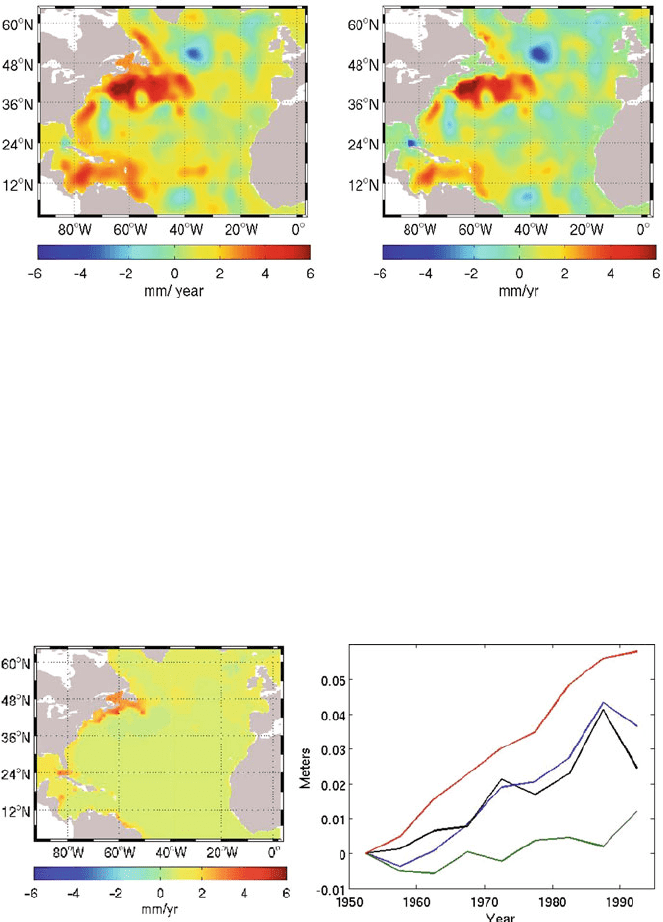
348 H. Reinhardt et al.
Fig. 6 The sea level rise of calibrated IFEOM for 1950–1994 (left). The mean sea level rise for
the complete model area is 1.18 mm/year. The right figure shows the trend of steric height with a
mean of 0.31 mm/year
The right panel in Fig. 6 shows the 0.31 mm/year in SLR due to steric effects.
The trend in ocean bottom pressure with a mean of 0.87 mm/year is depicted in
Fig. 7 (left) . It is to a large extent equally distributed over the model domain with
notable exceptions near the boundaries. In the right panel of Fig. 7 the mean of the
pentads for sea level, steric height and ocean bottom pressure is plotted. The fourth
curve is the mean sea level calculated from all gauges directly, which leads to a trend
in SLR of 1.54 mm/year. This is significantly larger than the 1.18 mm/year in SLR
from the calibrated IFEOM.
Fig. 7 The left panel shows the trend of bottom pressure (surface height minus steric height) with
a mean of 0.87 mm/year. The right panel shows the mean of the pentads for the calibrated sea level
of the IFEOM model (blue), the ocean bottom pressure (black), and the steric height (green)and
for comparison the mean sea level of all gauges (red).
Sea Level Rise in North Atlantic Derived from Gap Filled Tide Gauge Stations 349
5 Conclusions
Gap filling of observed sea level data can be performed with the MSSA method and
is stable with respect to different window length when long time scales are con-
sidered. MSSA can also be used for low pass filtering of the gap filled time series.
Our method of calibrating the basin wide sea surface topography derived from the
inverse ocean circulation model IFEOM with gauge data leads to reasonable results.
The trend in SLR, calculated directly from the tide gauges used for calibration,
is 1.54 mm/year. Our calibration converts this to a basin wide sea level rise of
1.18 mm/year which shows that coastal and regional sea level trends may differ
substantially (see also Holgate and Woodworth, 2004). In our results 0.31 mm/year
SLR are due to steric expansion while 0.87 mm/year are due to mass increase in the
North Atlantic.
References
Church JA, White NJ, Coleman R, Lambeck K, Mitrovica JX (July 2004) Estimates of the regional
distribution of sea level rise over the 1950–2000 period. J. Clim. 17(13), 2609\u20132625.
Ghil M, Allen MR, Dettinger MD, Ide K, Kondrashov D, Mann ME, Robertson AW, Saunders A,
Tian Y, Varadi F, Yiou P (August 2002) Advanced spectral methods for climatic time series.
Rev. Geophy. 40(1), 1003.
Holgate SJ, Woodworth PL (April 2004) Evidence for enhanced coastal sea level rise during the
1990s. Geophys. Res. Lett. 31(7), L07305.
Jevrejeva S, Grinsted A, Moore JC, Holgate S (September 12, 2006) Nonlinear trends and
multiyear cycles in sea level records. J. Geophys. Res. Oceans 111, C9.
Kondrashov D, Ghil M (2006) Spatiotemporal filling of missing points in geophysical data sets.
Nonlinear Processes Geophys. 13(2), 151\u2013159.
Lozier MS, Owens WB, Curry RG (1995) The climatology of the North Atlantic. Prog. Oceanogr.
36, 1–44.
Peltier WR (November 1998) Postglacial variations in the level of the sea: implications for climate
dynamics and solid-earth geophysics. Rev. Geophys. 36(4), 603\u2013 689.
Sidorenko D, Danilov S, Schröter J (2008) Inverse solution for pentadal variability in the North
Atlantic. Geophys. Res. Lett. 35, L02603.
Snay R, Cline M, Dillinger W, Foote R, Hilla S, Kass W, Ray J, Rohde J, Sella G, Soler T (April
25, 2007) Using global positioning system-derived crustal velocities to estimate rates of abso-
lute sea level change from North American tide gauge records. J. Geophys. Res. Solid Earth
112(B4).
Zervas C (2001) Sea level variations of the United States 1854–1999, NOAA Technical Report
NOS CO-OPS 036, Version July 2001.

Using ARGO, GRACE and Altimetry
Data to Assess the Quasi Stationary
North Atlantic Circulation
Falk Richter, Dimitry Sidorenko, Sergej Danilov, and Jens Schröter
1 Introduction
In the last years, two major observation systems have become operational. The first,
satellite altimetry, maps the ocean surface quasi synoptically, and by referencing
sea surface height to the GRACE geoid ocean currents are diagnosed. The second
observing system is the Global Array of Profiling Floats (ARGO) adding in situ
subsurface temperature and salinity data. Both types of measurements are consistent
with each other to such an extent that altimetry can be used to check the quality and
performance of individual temperature and salinity profiles measured by ARGO
(see e.g. Ivchenko et al., 2007; Guinehut et al., 2009). It is shown that both types
of measurements complement each other and a joint analysis is required in order to
fully exploit the information content.
We combine the two sources of data in the context of an ocean inverse general
circulation model. In this way we make use of dynamical rather than statistical cor-
relations between the data and analyse ocean currents and transports simultaneously
with the observations.
Generally, numerical ocean circulation models produce fields which differ from
observations. The bias is a result of many factors, which are in both, models and
measurements. On one hand models produce uncertainties due to the lack of suf-
ficient information on the surface forcing and errors in model dynamics. On the
other hand, the measurements themselves are contaminated by measurement errors
and include transient effects of the ocean dynamics which are not resolved by mod-
els. Assimilating all available information into an ocean circulation model could
serve the purpose of finding the compromise between model and data and obtaining
improved patterns of ocean circulation. This has been successfully demonstrated
in a series of works (Wenzel and Schröter, 1998; Wenzel et al., 2001; Wenzel and
Schröter, 2002; Stammer et al., 2002, 2003; Losch and Schröter, 2004; Kivman
et al., 2005).
F. Richter (B)
Alfred-Wegener-Institute for Polar- and Marine Research, D-27570 Bremerhaven, Germany
e-mail: Falk.Richter@awi.de
351
F. Flechtner et al. (eds.), System Earth via Geodetic-Geophysical Space Techniques,
Advanced Technologies in Earth Sciences, DOI 10.1007/978-3-642-10228-8_29,
C
Springer-Verlag Berlin Heidelberg 2010
352 F. Richter et al.
2 Model Setup and Data
The model used for the present study is an inverse finite-element ocean circulation
model (IFEOM) which has been described in Sidorenko et al. (2005). The model
solves the stationary momentum equations for velocity field and sea surface height,
and treats the advective-diffusive tracer balances as soft constraints. IFEOM seeks
for the temperature (T) and salinity (S) fields which give minimum to its objective
function. The latter penalizes residuals in the tracer equations, deviations of model
variables from data available and also the misfit between the diagnosed deep pres-
sure gradient and the pressure gradient of a prognostic model run. The experiments
reported below take into account several data sources. Gouretsky and Koltermann
(2004) climatology is used in all experiments as a background for temperature and
salinity.
The other dataset includes T and S profiles for the years 2005–2006 from the
ARGO project, available from the official ARGO web site (www.ARGO.ucsd.edu).
The ARGO data comes from a set of profiling buoys which contains seasonal and
transient signals. Because of a poor spatial coverage of ARGO data on a monthly
basis we restrict our results to annual model solutions. We use the annual mean of
ARGO data in our experiments with the seasonal signal removed.
Altimetry data is optionally taken as gridded maps of absolute dynamic topog-
raphy (MADT) provided by AVISO (Archiving, Validation and Interpretation of
Satellite Oceanographic data). Absolute dynamic topography is the sum of sea
level anomaly (SLA) and a mean dynamic topography (MDT). Following AVISO
the Rio05 MDT is used here. The Rio05 mean dynamic topography (Rio and
Hernandez, 2004 and Rio et al., 2005) is the combined product of large scale
MDT, using the CLS01 mean sea surface (MSS) and the EIGEN-GRACE 03S
geoid (Reigber et al., 2005), and hydrographic and Lagrangian data together with
altimeter SLA over t he 1993–2002 period. CLS01 shows the mean shape of the sea
surface during the period covered by t he altimetry data. It is corrected from sea-
sonal variations and corresponds to the sum of geoid + mean elevation in response
to ocean circulation. The annual means of MADT have been computed for the years
2005–2006.
Three experiments have been performed for each year for the period 2005–2006.
First, solutions are obtained by assimilating only the ARGO data (ARGO05-
ARGO06). Second, solutions that use only altimetry data (Alt05-Alt06) are found.
Finally, solutions using both, ARGO and altimetry are computed (AltARGO05-
AltARGO06). In the following, the adjustments produced by IFEOM in temperature
and salinity fields and the resulting circulation patterns are analysed.
3 Results
The sea surface elevation corresponding to the analysis of ARGO data with the
altimeter information included (AltARGO05) is presented in Fig. 1 for 2005. It
exhibits all major features of the North Atlantic dynamic topography, i.e. the warm
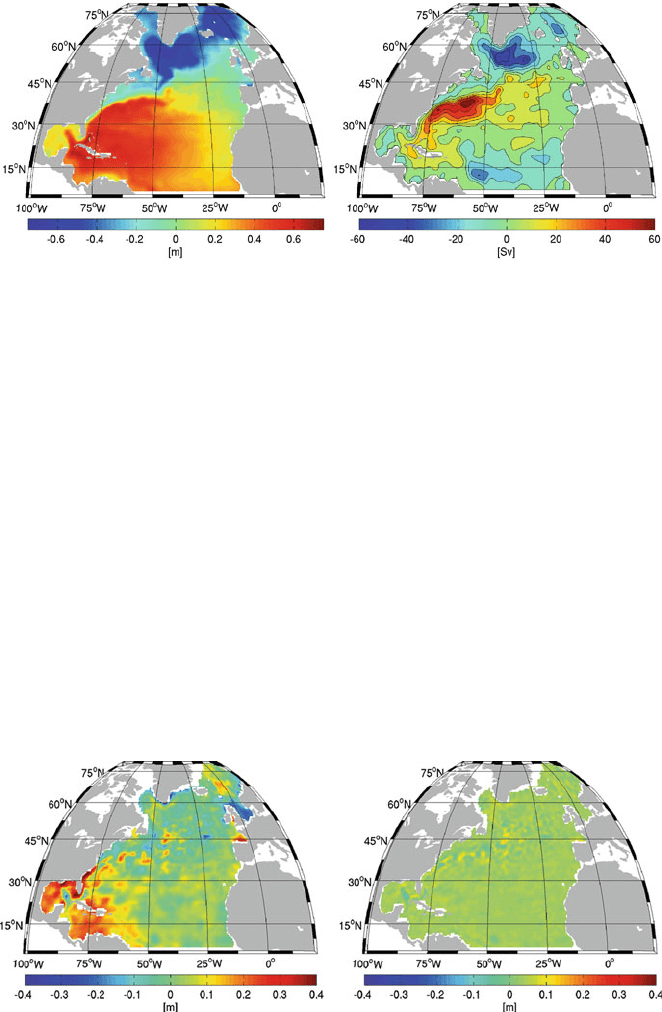
Using ARGO, GRACE and Altimetry Data t o Assess the Quasi Stationary 353
Fig. 1 Left panel: Modelled sea surface elevation (dynamic height) of the AltARGO05 experi-
ment. Right panel: the corresponding barotropic stream function
pool with a strong gradient toward the subpolar Gyre south of Greenland, the loop
current in the Caribbean basin, a strong Labrador current which continues around
the Grand Banks, a northward extension of the North Atlantic Current after its sep-
aration from the American coast at Cape Hatteras, and the Azores Current. Ocean
currents are in agreement with the conventional oceanic knowledge and are used for
the further analysis of the North Atlantic circulation and its interannual changes.
We analyse the impact of using altimetry on the model solution. Comparing
ARGO05, the experiment that excludes altimetry, with the independent altimeter
sea surface (Fig. 2, left panel ) we observe a large scale shift of about 80 cm, from
the Caribbean Sea to the subpolar gyre which shows that the circulation derived
from hydrographic data alone is far from the observed reality. Using only ocean
subsurface data produces a sea surface height with large scale spatial differences
to altimeter and geoid observations. Thus, the additional information on the ocean
circulation is necessary, and the obvious choice is to account for altimetry data in
the model. The success of this choice (AltARGO05) is demonstrated in Fig. 2,
Fig. 2 Difference of modelled sea surface elevation and altimetry data in 2005. Based on ARGO
only (left panel; ARGO05) and after including altimetry (right panel; AltARGO05)
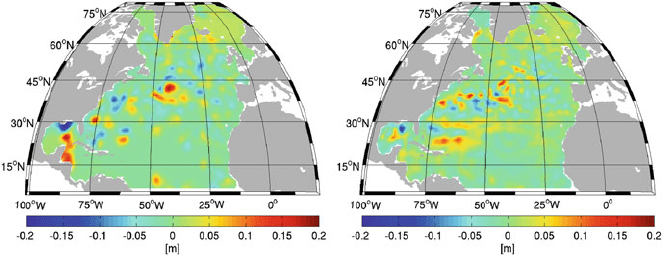
354 F. Richter et al.
Fig. 3 Difference in modelled sea surface change based on ARGO only (left panel; ARGO06-
ARGO05) and after including altimetry (right panel; AltARGO06-AltARGO05)
right panel. It shows the differences of AltARGO05 to altimetric data which are
an order of magnitude smaller than those for ARGO05. Referenced altimetry and
the dynamic topography of the inverse model can be matched by small adjustments
inTandStoanRMSmisfitof3cm.
One of the improvement by including altimetry is seen at an oceanographic sec-
tion at 24
◦
N. The heat transport across this line computed from AltARGO05 is
1.24 PW what compares perfectly with the values estimated by Lumpkin and Speer
(2007) and Ganachaud and Wunsch (2003). Their estimates are 1.24 ±0.25 PW
and 1.27±0.15 PW, respectively. ARGO05 underestimates the heat transport across
24
◦
N providing a value of only 0.89 PW.
In order to estimate the variability contained in ARGO and altimetry data the
intercomparison of temporal change in modelled topography between years 2005
and 2006 is presented in Fig. 3. The left panel shows s ea surface variability
based on ARGO (ARGO06-ARGO05), and the right panel displays the difference
(AltARGO06-AltARGO05) when all data are used.
Both patterns suggest a sea level rise of about 5 cm in Nordic seas. The Gulf
Stream region and its extension are characterized by large activity. The inter-annual
differences are up to 20 cm. The differences in variability between the two plots
are obviously due to the poor spatial sampling of ARGO data in comparison to
altimetry. The corresponding change in the solution AltARGO06-AltARGO05 is
similar to that of altimetry data (Fig. 4). It contains slightly smaller and less sharp
local anomalies, but takes into account a significant part of variability contained in
the data.
The model solution allows studying other characteristics of the circulation. We
discuss the transport and its variability. Barotropic stream function has been deter-
mined for the inverse solution using all data (AltARGO05) and is depicted in Fig. 1
right panel. The gyre structures are well developed, the strength of the subpolar
gyre is 50 Sv and is on the upper limit of most forward modelling studies (see
e.g. Treguier et al., 2005). Considering the temporal changes 2006–2005 we notice
differences of about 20 Sv with the maximum in Gulf Stream region seen in both
ARGO and AltARGO experiments (Fig. 5, left and right panels, respectively) with
